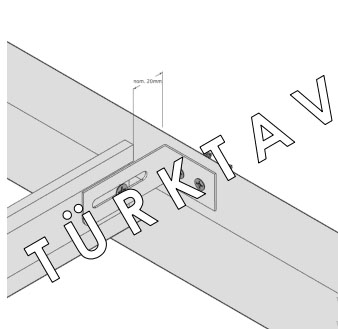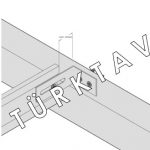SEISMIC
PROPS OF TURKTAV SUSPENDED CEILINGS
PROPS OF TURKTAV SUSPENDED CEILINGS
Kategori:
SEISMIC PROPS
When it comes to designing Turktav suspended ceilings to withstand seismic loads, there are several solutions to consider. But which one is the best? The answer largely depends on the nature of the project at hand. Here are some key points to consider when considering seismic support solutions:
• Differential movement between ceiling and building structure
• The weight of the ceiling and thus the magnitude of the seismic loads
• Designing the system to withstand horizontal seismic loads
• Transferring these loads back to the building structure by seismic crossing
Apparatuses used to seismically support suspended ceilings are given below with their visuals;
• Differential movement between ceiling and building structure
• The weight of the ceiling and thus the magnitude of the seismic loads
• Designing the system to withstand horizontal seismic loads
• Transferring these loads back to the building structure by seismic crossing
Apparatuses used to seismically support suspended ceilings are given below with their visuals;
CHAPTER ONE INTRODUCTION 1.1 Introduction Although non-structural elements (YOE) are not part of the structural structural system, they are elements whose integrity must be ensured in terms of earthquake effects. This necessity can be explained by the fact that the response of YOEs to earthquake forces significantly affects the functionality of the buildings after the earthquake, even if the structural system is not damaged. Severe damage to YOEs in past earthquakes has led to the evacuation of buildings, economic losses and, in some cases, loss of life. When the damages occurred in YOEs in the past earthquakes are examined, it is seen that the most damage occurred in Suspended Ceiling Systems (ATS) (Badillo, 2005). This damage, which is seen more in ATSs than in other YOEs, is in parallel with the widespread use of ATSs in almost all closed areas in many buildings (public buildings, hospitals, etc.). For this reason, the performance of ATSs during earthquakes is of critical importance depending on the intended use of the building. It was stated that the damage to the ATSs in the power plant in the 1971 San Fernando earthquake prevented the functionality of the control room (Sharpe, 1973). The massive damage to the ATSs at the San Francisco airport in the 1989 Loma Prieta earthquake led to the evacuation of the airport (Benuska, 1990). The damages that occur in ATS after the earthquake raises the questions of the applications of these systems in our country and the earthquake performance of these applications. In our country, there is TS EN 13964 standard related to ATSs. This standard provides the necessary information for the relevant parties responsible for the design, manufacture and selection of ATSs used in the interiors of buildings and other structures in the field of civil engineering, suspended ceiling carrier systems sold as a set of components, individual components of these carrier systems and suspended It includes ceiling covering components, requirements that ATSs must meet (modular size, structural system mechanical resistance, fire, acoustics, durability, thermal insulation etc.) and test methods (bending, tensile, wind load, impact, etc.) related to these requirements. (Turkish Standards Institute [TSE], 2008). However, there is no clause in this standard that defines the installation conditions of ATSs. According to TS EN 13964, the assembly of these systems is carried out according to the instructions of the supplier company. However, this article causes differences in the applications related to ATSs in the market. But when we examine the standards abroad, we see that things are carried out differently. For example, in the USA, the assembly of ATSs is carried out to meet the minimum conditions defined in ASTM E580 in force (American Society for Testing and Materials [ASTM], 2011). Although there is a standard for ATS in our country, the presence of low quality suspended ceiling components that do not comply with the current standard has an increasing effect on the losses of ATS due to earthquake damage. 1.2 Purpose and Scope of the Project 1.2.1 Purpose In light of the above-mentioned considerations, it is necessary to reduce the risk of damage to ATSs. For this purpose, it is aimed to make a situation assessment of the behavior of ATSs of different qualities used in our country under seismic forces, by creating physical models of suspended ceiling products used in Turkey under laboratory conditions and performing tests under dynamic loads that simulate earthquakes. 3 1.2.2 Scope Many types and qualities of ATSs are used in the market. Within the scope of the project, dynamic tests of high quality and low quality ATSs, which are most used in the market, were carried out on the shaking table in Dokuz Eylul University Structural Engineering Laboratory. In the dynamic experiments carried out, a suspension frame designed to test ATSs in real boundary conditions, with plan sizes of 3.0 m - 2.4 m, was used within the laboratory and shaking table possibilities. The mounting technique of ATSs on this suspension frame has been made within the framework of market practices, separately for low quality and high quality materials. Considering the above-mentioned information, within the scope of the experimental study; i) General dynamic behavior of suspended ceiling systems (sitting system, concealed carrier system) created by using different carrier elements (T24, special concealed carrier), ii) The effects of different quality suspended ceiling materials on the performance of ATSs under dynamic loads, iii) Different weights The effects of plate types (steel sheet and plaster) on the overall behavior, iv) The effects of carrier end clips on the dynamic behavior of ATSs will be investigated. 1.3 Main Lines of the Project Investigation of the behavior of suspended ceiling systems of different qualities used in our country under earthquake-simulating loads and increasing the earthquake performance of the current situation.




